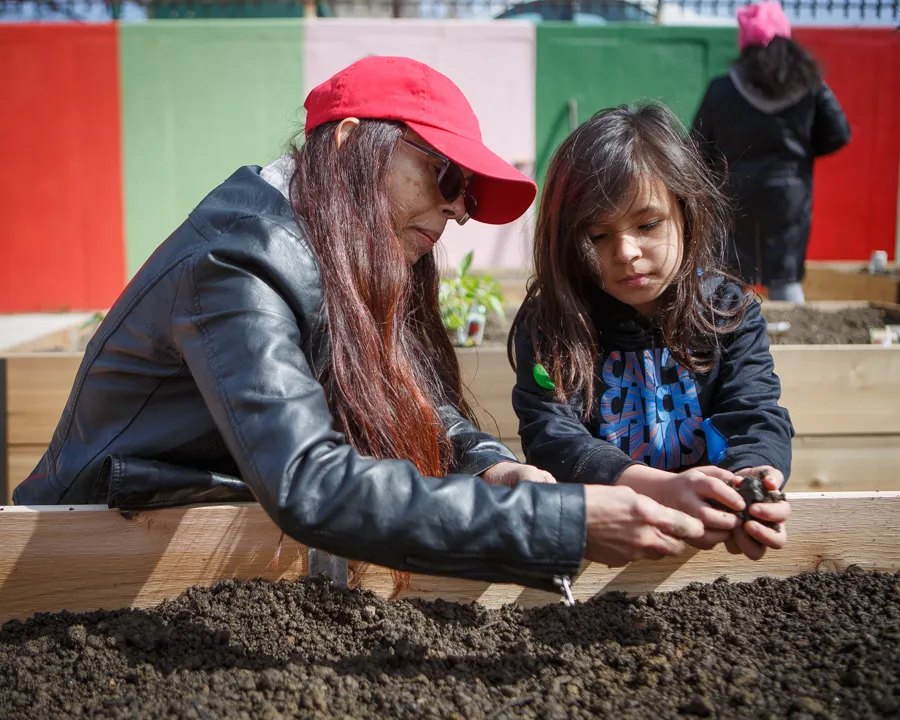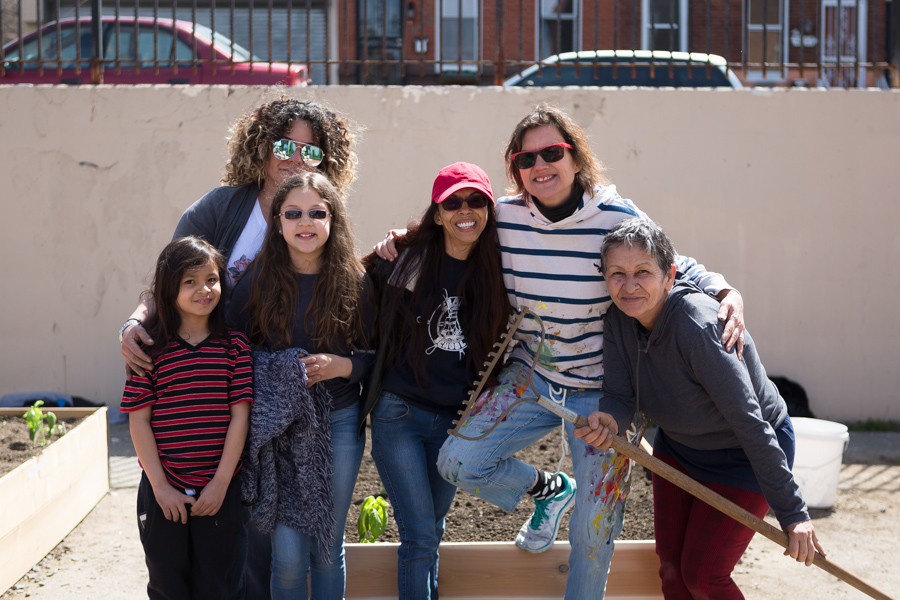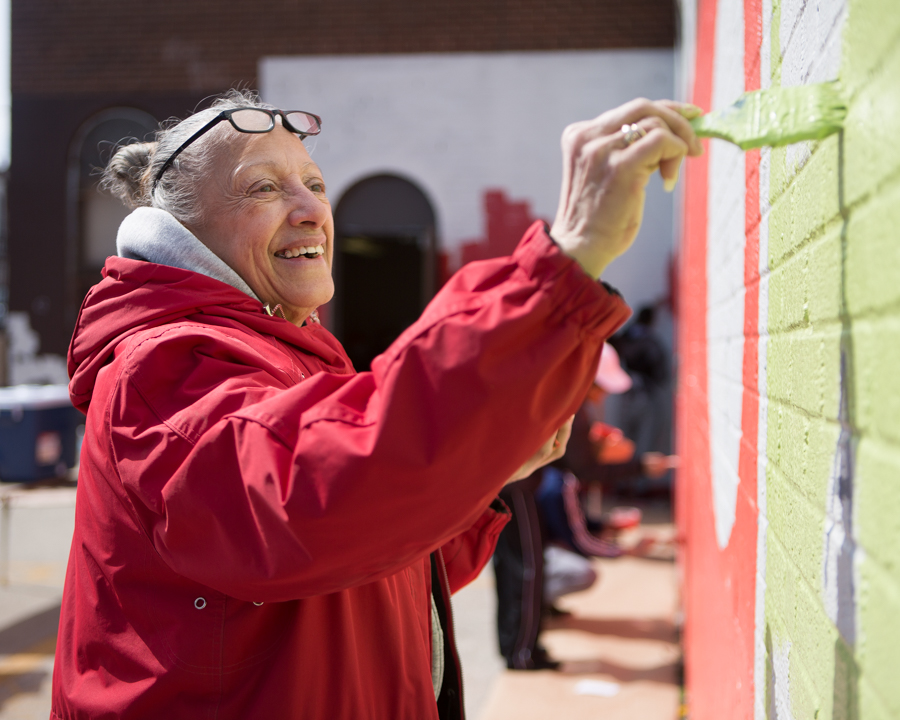How to Plant Seeds in a Community (Garden)

The north courtyard of William Cramp Elementary in Fairhill is a little brighter this year—thanks to Uprooted/reRooted, an ongoing project from the Restored Spaces initiative, parents and students have come together to make the space welcoming, educational, and nourishing. Artist Marion Wilson has been embedded as the artist-in-residence since the spring of 2017, leading a constantly-evolving project that will eventually result in a botanical mural around the school building. As flowers begin to bloom around the city, read on to learn more about Wilson’s thoughts on gardens and growth.
How did the community garden concept develop for this project?
Marion: We have a committed group of five or six parents—mostly women, one man, a couple of grandmothers. They wanted to green the space at the school, because a couple of them grow food at home, several have worked in community gardens, a couple have ancestors who were farmers, so there is a big agricultural background and interest. The great thing about a community garden is that it evolves.
The first thing was to work with the most under-used space at Cramp—the north courtyard—using several contemporary artists as inspiration (Felix Gonzalez-Torres, Doris Salcedo, and Robert Smithson). We designed planters and divided the looming courtyard space into three workable parts. That’s really where we got our themes, from the lessons in art history and the parents’ interests. One woman wanted it to be all about food, another person wanted it to be about kids, and another person wanted it to be a healing garden—a meditation space, a space of silence.
We bonded over shared parenting stories, stories of love, shared food, and out of that a larger narrative developed that speaks not only to the mission of the community school, but also to the fabric of the neighborhood. There’s a really strong sense of family there, and each of us are the heads of single-parent households—so we all have very rich domestic lives. Through these themes, we took a space that can seem cavernous and made it intimate: a place where learning can happen and the community can gather.
I’m interested in your thoughts on community and power dynamics. If it’s important to you that the community has ownership over their own space, how do you facilitate that as an outsider?
Marion: I’ve had the experience of moving and leaving behind other large community-based projects, and I’ve seen how their success can be too dependent on my presence. You don’t want that, as an artist. It’s just etched into my mind that I’m probably going to be walking away from the project at some point, I’m the one that’s always going to be leaving. Right from the beginning, I have to ask myself: what’s your exit strategy? It sounds cold, but it’s necessary. Some people use the word sustainability to talk about this issue. This community was so easy to enter—maybe it’s because I spoke Spanish at one of the meetings, or maybe it’s just a very welcoming community, or maybe it was the studio space where people could come in and draw, which is a great physical connector. I’ve never worked in a community that has felt so inclusive of me, and vice versa.
The project started in April 2017 with the school agreeing to give me a studio in the building. I would be an embedded artist-in-residence who showed up and did work and ran the studio. The space that they gave me was an un-used boys’ shower stall and locker room, which was filled with boxes. The first thing I did was to move everything out and scrub it. Then I turned the shower stall into a grow room with plants, and made it a site for people to take field trips within the school, and to grow seeds before the ground had thawed, and to get to know some of the students.
Why was that important to building trust? How did that bring you into the community in a meaningful, thoughtful way?
The fact that I cleaned and scrubbed that shower stall, that I made friends with the building manager and the woman who cleans the building—not everyone gets a smile from the woman who cleans the building, but she comes to make sure I have all the garbage bags that I need. So I became the person who cleans the building. The most insignificant part of the building, I’m scrubbing. These are domestic rituals—cleaning the shower stall, taking field trips and stopping at Burger King, and sharing food and sharing recipes and talking about who’s coming for dinner, their kids coming home and my kids not coming home—all these feelings related to family and domestic life. That’s the constant conversation while we were getting the project done.
When I first asked the school for help moving into the space, someone said to me, “All you’re gonna get here is a bunch of 50-year-old women to help you.” Hah! First of all, I’m 50, but second: that is the team. And that same person now comes and asks me, “How are you getting so much help and investment?” Look at who’s there and see their value, and build on it.
Uprooted/reRooted is funded by the City of Philadelphia Mayor’s Office of Education, FAO Schwarz Family Foundation, JPB Foundation, PTS Foundation, and Stavros Niarchos Foundation. Partners include Community Schools, Interpret Green, Philadelphia Orchard Project, and the School District of Philadelphia.








